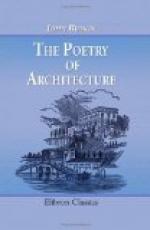II.
THE MOUNTAIN VILLA—LAGO DI COMO (Continued).
113. Having considered the propriety of the approach, it remains for us to investigate the nature of the feelings excited by the villas of the Lago di Como in particular, and of Italy in general.
We mentioned that the bases of the mountains bordering the Lake of Como were chiefly composed of black marble; black, at least, when polished, and very dark gray in its general effect. This is very finely stratified in beds varying in thickness from an inch to two or three feet; and these beds, taken of a medium thickness, form flat slabs, easily broken into rectangular fragments, which, being excessively compact in their grain, are admirably adapted for a building material. There is a little pale limestone[17] among the hills to the south; but this marble, or primitive limestone (for it is not highly crystalline), is not only more easy of access, but a more durable stone. Of this, consequently, almost all the buildings on the lake shore are built; and, therefore, were their material unconcealed, would be of a dark monotonous and melancholy gray tint, equally uninteresting to the eye, and depressing to the mind. To prevent this result, they are covered with different compositions, sometimes white, more frequently cream-colored, and of varying depth; the moldings and pilasters being frequently of deeper tones than the walls. The insides of the grottoes, however, when not cut in the rock itself, are left uncovered, thus forming a strong contrast with the whiteness outside; giving great depth, and permitting weeds and flowers to root themselves on the roughnesses, and rock streams to distill through the fissures of the dark stones; while all parts of the building to which the eye is drawn, by their form or details (except the capitals of the pilasters), such as the urns, the statues, the steps, or balustrades, are executed in very fine white marble, generally from the quarries of Carrara, which supply quantities of fragments of the finest quality, which nevertheless, owing to their want of size, or to the presence of conspicuous veins, are unavailable for the higher purposes of sculpture.




